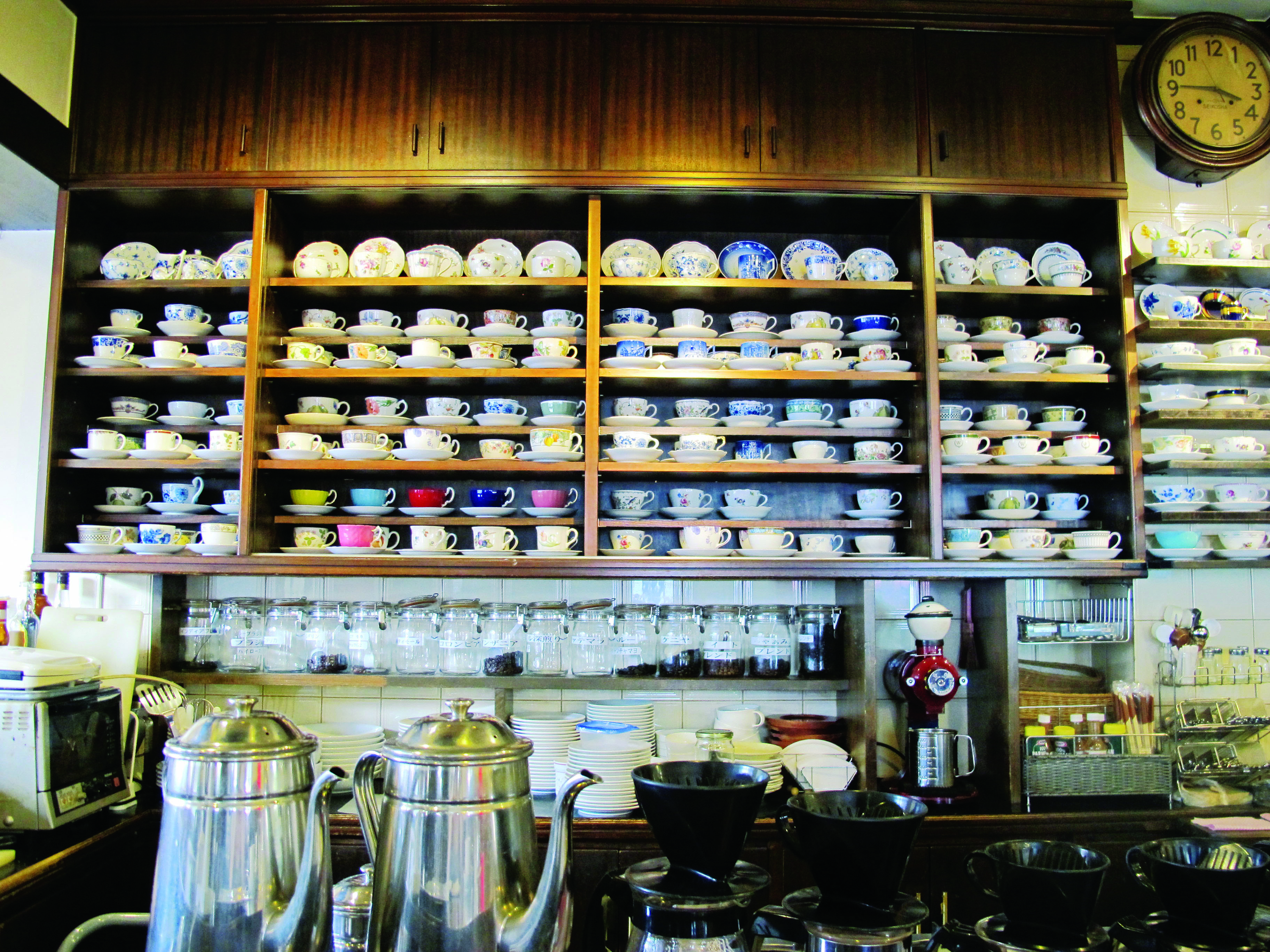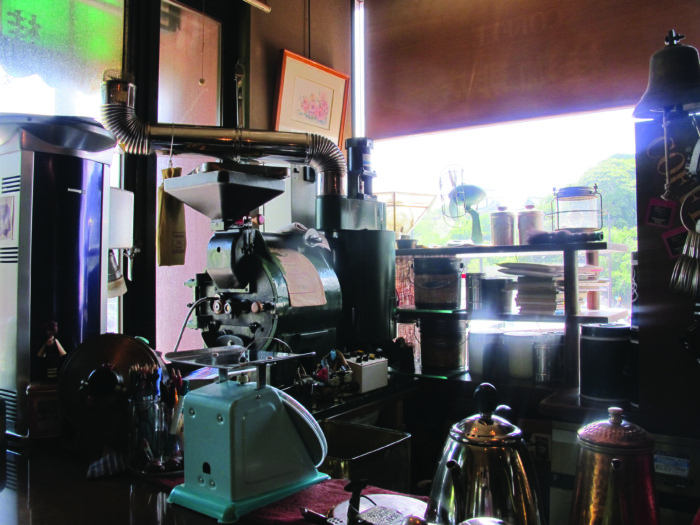
Katsura Coffee in Kanazawa, Japan, has no menu. Instead Toshio Sakaguchi, 77, greets you with a piercing look and a blunt, “What do you want to drink?” And since it’s not apparent what types of coffee beans are available, either, you have to ask by flavor profile. Whatever you get then will be up to him.
“Can I make it stronger?” Mr. Sakaguchi asked, after I requested a medium roast, and though my nod was hesitant he seemed pleased. I guess I passed his taste-test — an average cup of hand-drip coffee in Japan has anywhere between 12 and 25 grams of beans per cup, making it stronger than most coffee you find in America.
As Mr. Sakaguchi poured beans from a slightly dented tin onto a scale, I idly looked around. The counter was full of vintage grinders and small cat figurines: gifts from regulars. Mellow jazz music was playing from hidden speakers. Once Mr. Sakaguchi handed me my coffee, served in a blue porcelain teacup decorated with gold monkeys, I asked him about all his different machines.
“You have to have a different machine for the type of coffee you want,” he said. “Depending on the type of coffee, the fineness of the grind changes. And I do all the maintenance myself.” He proffered the manual for a German Probat roaster, predictably written in German — although the margins had handwritten notes in Japanese. “That’s what defines a pro — that, and being able to taste every single bean used in a coffee blend in one sip.”
Mr. Sakaguchi had apparently made me a cup of coffee that used four different beans, but there was no way I could tell you what sort of beans they were. Nor, I assume, would the average Japanese consumer.
—
Katsura Coffee — small, cluttered, clean but worn, and completely coffee-focused — is what’s known as a kissaten. Kissaten translates to “coffee house” or “coffee shop,” but there is a much more historic and atmospheric connotation than your average neighborhood Starbucks. Kissaten are practically a Japanese cultural institution, and they’ve been around longer than one might think: The first coffee house in Japan was opened in 1888 by a man named Tei Ei-kei, a Yale alum.
Anthropologist Merry White describes Ei-kei’s life and vision for this coffee house in her book, Coffee Life in Japan. A gifted linguist, Tei Ei-kei attended Yale from 1875, at the age of 16, until 1879, when he had to abruptly stop his studies. He found his taste for coffee while in America, and upon returning to Japan he opened the Kahiichakan, a “space to share knowledge, a social salon where ordinary people, students and youths could gather,” according to Tei Ei-kei’s friend, Terashita Tatsuo. The Kahiichakan was a space of bunmei kaika (civilization and enlightenment) — which in the late Meiji Era from 1868–1912 meant “Western” — that Tei Ei-kei based off time he had spent earlier in London.
The Kahiichakan was less coffee shop and more elite male social club, its amenities going far beyond what was typically offered in coffee shops: social games, leather chairs, smoking, newspapers and more, for the price of a cup of coffee. And there was no time limit on how long you could stay.
In the end, Tei Ei-kei had a revolutionary idea but poor business sense. The Kahiichakan went out of business in 1893, just five years after opening. But Ei-kei’s legacy remained — kissaten and coffee would become a staple in the Japanese social sphere and a strong influence on global coffee practices.
—

It’s difficult to explain what distinguishes a kissaten from another type of coffee shop — and while modern kissaten have some of the flavor of Tei Ei-kei’s Kahiichakan, they’re quite different.
Though some kissaten do specialize in providing a specific atmosphere or experience (Meikyoku Kissa Lion in Tokyo is what’s known as a “classical music kissaten”), atmosphere is largely secondary to the coffee, as opposed to the Kahiichakan, where popular Western sensibilities and fashions were functionally on display. The “Masters” and “Mamas,” as kissaten proprietors are called by their regulars, are the original “coffee nerds” of Japan, and their quirks and experiments drove coffee from a basic beverage to a drink with strong emphasis on craftsmanship.
More importantly, each kissaten’s Master or Mama has their own flavor profile. The same roast will taste completely different depending on the shop, because each one’s brewing method will differ. Even though kissaten owners are searching for coffee perfection, there isn’t a single definition of delicious, or even one “best” method of brewing — and Masters and Mamas typically have no qualms about bashing methods they feel are inferior to their own.
“Tachikoohii?” Mr. Sakaguchi scoffed when I mentioned an elaborate apparatus I’d seen at another shop that makes cold drip “standing coffee” over a period of eight hours. “Too much air gets into the coffee as it drips down the glass.” He was adamant that his “open pot” method was the best. “Paper filters are no good,” he added later. “They make the coffee taste bad.”
That’s not to say that kissaten design isn’t also important. Small and frequently dominated by a large counter, the layout does much to encourage socialization. Customers sitting at the counter can socialize with the Master — if he’s of a chatty temperament — or others sitting around them, companionably smoking, drinking and relaxing. One kissaten I visited had a row of regulars taking up the entire counter, and even though they came in at different times during the morning, there was an easiness and a friendliness about their interactions that spoke to many years of frequenting the same place. That can make it intimidating for newcomers, who may feel like they’re intruding on this space of previously established relationships.
“I want to create a ‘new culture’ where it’s easy for people to talk with each other,” said Mr. Akagawa, a champion latte artist at The Theater Coffee in Tokyo. He used his hands to illustrate a triangle of communication between customer A, customer B and the shop’s Master. He described how he wanted to create a community where people with different goals — socializing, studying, relaxing — could mix together harmoniously. “My favorite part is communicating with customers.”
—
Ironically, what made kissaten unique and popular in the past — their intimate settings, the possibility to develop close relationships with owners and other customers, and their fastidious attention to the coffee — is making them less popular in Japan today. “They’re just not cool anymore, not casual,” said Eric Tessier, founder of and blogger at tokyocoffee.org. “When you sit at the counter of a kissaten you can’t hide away.”
The younger generations are drifting away from kissaten and toward coffee shops and cafes that have a different atmosphere — bright, photogenic and tech-friendly. Places where take-out is an option are also increasing: corner coffee stands don’t have seating, but offer quality coffee to-go for someone who simply doesn’t have time to sit down. Many Masters lament that 100-yen (about $1) convenience-store coffee and chain brands are eating into profits.
Kissaten certainly remain influential: Many contemporary coffee shops take concepts and brewing techniques from kissaten and apply it to their own work. But it’s hard to feel confident ordering coffee when a single shop has over 10 types of beans to choose from; many customers I spoke to about their habits mentioned that they often deferred to a Master’s recommendation because they didn’t know what bean would be delicious or not.
Ultimately, the belief that people should have fun with and enjoy their coffee remains the same. “Koohii wo tanoshimu” or, “to enjoy coffee” is a phrase that’s at the heart of coffee culture in Japan. Not only do the customers enjoy the coffee they purchase, but those making the coffee also enjoy experimenting with and improving their brew methods. By merging tradition and change, even new spaces can be considered a de facto “modern kissaten.”
—
Mr. Sakaguchi, however, remains committed to tradition and, above all, his definition of quality — even if it means less business. As he and I were drinking and chatting, a man popped his head in the door and asked if smoking was allowed. Pointing to a “no smoking” sign, Mr. Sakaguchi shook his head and the potential customer left.
“Smoking isn’t good for drinking coffee,” he said. “It’s bad for tasting and smelling.” I hadn’t heard that before, but perhaps his mentality could help bring kissaten closer to the present-day coffee shop standard. Or maybe not.
All I know is that if I ever return to Kanazawa, Mr. Sakaguchi would still be running Katsura Coffee — open seven days a week, from 1 to 6 p.m., no exceptions — and a hot, strong cup of coffee would be waiting for me.







